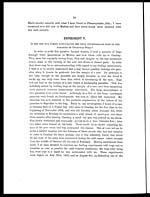Medicine - Institutions > Army health reports and medical documents > Scientific memoirs by officers of the Medical and Sanitary Departments of the Government of India > Number 50 - Preliminary report on an investigation into the etiology of Oriental sore in Cambay > Preliminary report on an investigation into the etiology of Oriental sore in Cambay
(19) Page 9
Download files
Individual page:
Thumbnail gallery: Grid view | List view

9
were examined, but nothing was found in them. During the cold weather, this
fly was never seen or felt, although it was carefully searched for in likely
places; owing to its painful bite it is well known to the inhabitants, but I could
obtain no information which would shew that there were any present during
the cold weather when the disease is most frequently contracted.
Philaematomyia insignis Austen, a common cattle fly, was abundant in
Cambay throughout the year, but I was unable to obtain any positive inform-
ation that this fly bites human beings; I have only known it to bite man on
three occasions in Madras. It never contains any flagellates.
Stomoxys calcitrans, also common in Cambay, rarely, if ever, bites human
beings; it is frequently infected with a natural herpetomonas. No feeding
experiments were carried out with either of these flies.
Two non-biting flies, Musca pattoni, Austen, and Musca convexifrons,
Thomson, are common in Cambay, and, as in Madras, they have the remark-
able habit of sucking up the blood which exudes from the bites of Philaemato-
myia, Stomoxys, Tabanus, Chrysops and Haematopota inflicted on cattle.
They were never however seen sucking up the discharge from sores.
In view of the recent work of Basile, that the dog flea Ctenocephalus
canis* is the probable transmitter of Canine and Infantile Kala Azar, and see-
ing that street dogs were numerous in Cambay I endeavoured to find out
whether fleas could have anything to do with the transmission of the parasite.
These dogs seldom, if ever, go into the people's houses, but live entirely on the
streets, and I never saw or heard of a single one having a true Oriental Sore.
Fleas ( Pulex irritans and Ctenocephalus felis were chiefly prevalent during the
cold weather, but I was unable to get them in sufficient numbers to carry out
feeding experiments and the inhabitants of Cambay could give me no infor-
mation regarding these fleas as being the probable carriers of the parasite.
With regard to fleas, it should be remembered that they are commonly infected
with natural flagellates, crithidia and herpetomonads, for Miss Porter has
recently recorded a crithidia from the alimentary tract of Pulex irritans and I
have found a species of herpetomonas in Ctenocephalus felis, indistinguishable,
both in its preflagellate and flagellate stages, from the parasites of Kala Azar
and Oriental Sore. This herpetomonas is found in about 5 per cent. of this flea,
and probably also occurs in C. canis. It is important to note that the flea ac-
quires the infection in its larval stage and that unless this fact is remembered, it
would be very easy, on finding flagellates in an adult flea taken off a dog infect-
ed with Kala Azar, to come to the conclusion that they represented stages in
the development of the dog parasite. The figures and descriptions given by
* I have it on the authority of the Hon. N. C. Rotschild that there is no such flea as Ctenocephalus
serraticeps, and that the flea mentioned by Basile is none other than Ctenocephalus canis.
Set display mode to: Large image | Zoom image | Transcription
Images and transcriptions on this page, including medium image downloads, may be used under the Creative Commons Attribution 4.0 International Licence unless otherwise stated. ![]()
| Permanent URL | https://digital.nls.uk/75061476 |
|---|
| Shelfmark | IP/QB.10 |
|---|---|
| Additional NLS resources: | |




